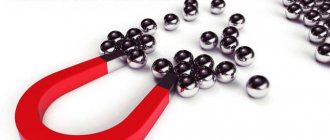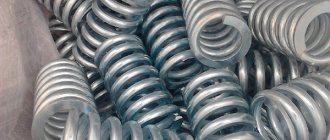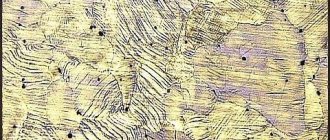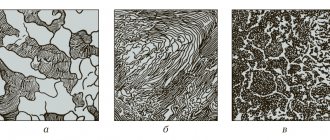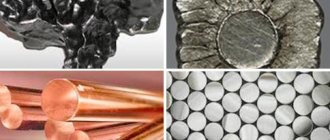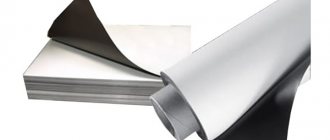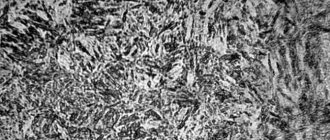Stainless steel, or corrosion-resistant steel, is an alloy of iron and carbon. It contains chromium, from which chromium oxide is formed with the help of oxygen, and due to this, an oxide film is created on the surface, protecting the product from corrosion. In this article we will talk about the properties of this type of steel and find out whether stainless steel is magnetic.
Properties of corrosion-resistant steel
The alloy contains at least 10.5% chromium. In addition to its anti-corrosion properties, it adds some positive qualities to fame:
- easy processability by cold forming;
- high resistance to atmospheric corrosion and various chemical influences;
- sufficiently high strength;
- durability in use without loss of their qualities and performance properties, the average service life of such alloys is approximately 40-50 years;
- decent appearance, smooth surface;
- It is quite easy to clean from contamination with household detergents, which makes its maintenance more economical than that required by products made from ordinary steel;
Currently, more than 250 types of stainless steel have been created, which contain not only chromium, but also nickel, cobalt, titanium, molybdenum, and niobium. The performance properties and scope of application of the steel depend on what chemical element and in what quantities is added to the alloy. Carbon is an essential element in stainless steel. Thanks to it, the alloy acquires hardness and strength.
Classification of magnetic materials
In electrical devices, mainly ferromagnetic materials are used - iron, nickel, cobalt and their alloys.
Depending on the width of the hysteresis loop, ferromagnetic materials are divided into soft magnetic and hard magnetic. Magnetically soft materials are usually used to work in an alternating magnetic field, since the small width of the hysteresis loop (Fig. 350, a) causes relatively small energy losses when
Rice. 350. Hysteresis loops of magnetically soft (a) and magnetically hard (b) materials
magnetization reversal. Soft magnetic materials include electrical steel, which has a low coercive force and high magnetic permeability. Therefore, it is used for the manufacture of magnetic circuits in electrical machines and devices. Alloys of iron and nickel - permalloy - have even greater magnetic permeability and lower coercive force; iron, aluminum and silicon - alsifer, etc., which are used in radio engineering and automation devices.
Hard magnetic materials (Fig. 350, b) are used for the manufacture of permanent magnets used in electrical measuring instruments, telephones, some relays, etc. These include hardened carbon steel, cobalt steel and various alloys of aluminum, nickel, iron, cobalt: Magnico, Alnico, etc.
As can be seen from the magnetization curves (Fig. 351, a), ordinary steel or cast steel (curve 3) reaches magnetic saturation at higher inductions than cast iron (curve 1). Electrical steel (curve 4) reaches saturation at even higher inductions. Some ferromagnetic materials, for example, different grades of permalloy, have a rectangular hysteresis loop (curve 2). They are widely used for the manufacture of magnetic amplifiers, as memory elements in computers, etc. The higher the magnetization curve is, the less magnetizing current is required to create the required induction in the ferromagnetic material and the better it transmits magnetic flux.
If you successively change the highest values of the field strength H, you can obtain a family of symmetrical hysteresis loops 1, 2, 3, 4 (Fig. 351, b). The largest loop that can be obtained for a given material is called the limiting hysteresis loop, and the O-A curve passing through the vertices
Fig. 351 Magnetization curves of various materials (a) and hysteresis loops at different values of the highest induction (6)
symmetrical hysteresis loops—the main magnetization curve. It is used when calculating magnetic circuits of electrical devices.
Physically, the occurrence of residual magnetism and saturation is explained by the fact that in ferromagnetic materials, groups of atoms and molecules form elementary magnets (domains), spontaneously magnetized in a certain direction. In the absence of an external magnetic field, the domains are oriented in different directions (Fig. 352, a). During magnetization, the process of displacement of the boundaries separating neighboring domains first occurs.
In this case, those domains in which the magnetic fields of the atoms are close in direction to the external field (that is, they form an acute angle with it) increase, absorbing adjacent domains (Fig. 352, b). This process occurs abruptly and takes place on the straight part of the magnetization curve.
At a sufficiently high external field strength, domains in which the magnetic fields of the atoms are oriented against the external field (i.e., form an obtuse angle with it) completely disappear (Fig. 352, c). With a further increase in intensity, the magnetic fields of atoms in all domains rotate in the direction of the external field (Fig. 352, d). When these fields in all domains are oriented in the direction of the external field, magnetic saturation is practically achieved. When a ferromagnetic substance is demagnetized, the same processes occur in it as during magnetization, but in the reverse order. However, the nature of their occurrence is significantly influenced by the crystal structure of ferromagnetic materials. All ferromagnetic substances are magnetically anisotropic, i.e., magnetization occurs in them in different ways depending on the direction of the external magnetic field relative to the axes of the crystal. For example, in an iron crystal, magnetization along the edge of a cube (Fig. 353, a) can be carried out at a lower intensity (that is, it requires less energy) than magnetization along the spatial diagonal. These directions are called the easy and hard magnetization directions, respectively. If you begin to demagnetize a ferromagnetic substance, then the magnetic fields of atoms in all domains will gradually move further and further from the position shown in Fig. 352, g, turning towards the nearest axis of easy magnetization. When the external field strength becomes zero, the magnetic fields of all atoms will not return to their original state, but will be oriented along the easy magnetization axis closest to the direction of the field. As a result, the induction of its own magnetic field in a ferromagnetic substance will not be equal to zero, i.e., residual magnetism appears in it.
Magnetic properties of stainless steel
It is impossible to distinguish between the stainless steel in front of you and ordinary steel by eye. It is believed that stainless steel should not be magnetic, but it is quite difficult to obtain a reliable result. It happens that steel, which is not magnetic, perfectly resists rust, and vice versa, a product that has the ability to magnetize rusts. The magnetic properties of stainless steel depend on the chemical composition of the alloy.
Bodies that are in a magnetic field have the ability to be magnetized and are divided into:
- paramagnetic materials have a magnetic susceptibility coefficient greater than zero;
- diamagnetic materials have a magnetic susceptibility coefficient below zero;
- ferromagnets have increased sensitivity to magnetic fields and are intensely magnetized even in the presence of weak magnetic radiation. They are used as additives to stainless steel, improving its performance characteristics.
Soft magnetic steels
Soft magnetic materials are characterized by high magnetic permeability and low magnetic losses during magnetization reversal. They are widely used as transformer cores, chokes,
armatures, stators of electric machines, electromagnets, etc.
In low current technology, alloys based on iron-nickel (for example, permalloy) are used - Ni-Fe alloy; on an iron-cobalt base (for example, permendur) - Co-Fe alloy; mixed ferrites (for example, a combination of nickel and zinc ferrites).
Electrical steels include iron-based alloys containing 0.3-0.6% silicon and 0.1-0.3% manganese and are used in the production of electrical generators, transformers, etc.
Pure iron and low-carbon (0.05-0.005% C) thin sheet steel with a silicon content of 0.4 to 4.8% are used as soft magnetic materials with high saturation induction.
Electrical soft magnetic steel is produced in the form of rolls, sheets and cut strips. They are marked as follows. The numbers in the steel grade sequentially mean: the first - the type of rolling and structure; the second is the silicon content; third - the main characteristic; the fourth is the serial number of the steel type. According to the type of rolling and steel structure, they are divided into: 1 - hot-rolled isotropic; 2 — cold-rolled isotropic; 3 - cold-rolled anisotropic (textured).
According to the silicon content, steels are divided: 0 - with a silicon content of up to 0.4%; 1 - 0.4 - 0.8% Si; 2-08 -18% Si; 3 - 1.8 - 2.8% Si; 4 - 2.8-3.8 Si; 5 - 3.8-4.8% Si.
According to their main characteristics, steels are divided into three groups:
0 - specific losses at magnetic induction 1.7 T (in Tesla) and frequency 60 Hz; 1 - specific losses at magnetic induction 1.5 T and frequency 50 Hz, etc.
The industry produces the following steel grades:
1. Hot rolled thin sheet steel - 1211,1212, 1213, 1311, 1411, etc.
2. Cold-rolled isotropic thin-sheet electrical steel - 2011,2012..., 2111,...2211...,2311... etc.
3. Cold-rolled anisotropic (textured) sheet steel - 3411, 3404... etc. The magnetic properties of these steels in the longitudinal rolling direction are much higher than in the transverse direction.
Fe-Ni alloys (permalloy) are used as soft magnetic materials with high magnetic permeability.
All permalloys are divided into two groups:
— low-nickel: 50N, 65NP, 50НХЭ with a content of 40-65% Ni having a high magnetic permeability (μ up to 4000 Gauss/E) with a relatively high saturation induction (15 kG);
— high-nickel: 79НМА, 80НХС, 76НХД with a content of 75-80% Ni and having extremely high magnetic permeability (μ up to 35000 Gauss/E, but lower saturation induction (up to 7.5 kG).
The first group of permalloys is used for the cores of magnetic transformers, chokes, relays and parts of magnetic circuits operating in the field of high induction.
The second group of permalloys is used for magnetic screens, cores of small-sized transformers and other devices operating in weak magnetic fields. These alloys are produced in the form of cold-rolled sheets and strips with a thickness of 0.0015 - 2.5 mm, hot-rolled sheets with a thickness of 3-22 mm and rods with a diameter of 8-100 mm.
Soft magnetic materials include ferrites, which have a high electrical resistance of 103 - 10 Ohm∙cm. (which leads to low losses at high frequencies) and a relatively low saturation magnetization of 100-20000 Gauss.
Ferrites are produced by sintering powders consisting of Fe2O3 and oxides ZnO, NiO, MnO, etc. Soft magnetic ferrites NiO - ZnO - Fe203 and MnO - Fe2 03 are more often used. The parameter that determines these ferrites is the initial magnetic permeability μ0, which can vary widely limits and is indicated at the beginning of the ferrite grade. Thus, nickel-zinc ferrite (NiO - ZnO - Fe2O3) is designated 2000НН, 1000НН, 600НН, etc., and manganese-zinc ferrite (MnO - ZnO - Fe2O3) - 600НН, 1000ННЗ, etc.
Ferrites are used to operate at high and ultra-high frequencies. They are used in radio electronics and radio engineering for magnetic amplifiers, pulse transformers, etc.
How to determine the corrosion resistance of steel
To find out whether steel is corrosion resistant or not, you need the following steps:
- thoroughly clean a small area of the part;
- apply a couple of drops of copper sulfate solution;
- if the product is covered with a layer of red copper, then the alloy is susceptible to rust; if nothing has happened, then it is stainless steel.
The degree of corrosion resistance can be determined by the number of main elements that make up the alloy - nickel and chromium. If the chromium content is more than 12%, then this alloy will be anti-corrosion in normal environments; if it is more than 17%, then it can withstand even an aggressive alkaline environment.
Stainless steel that is magnetic
Ferritic alloys
They contain chromium in large quantities, approximately 20%. They have high magnetic properties and resistance to corrosion. They acquire greater softness due to a decrease in carbon composition and are easily amenable to various types of processing. Most often, such alloys are used in heavy industry, at food industry enterprises, and elements of heating systems are also made from them. They are cheaper than austenitic alloys.
Some features of ferritic alloys allow them to be used to replace more expensive materials:
- low level of thermal expansion and thermal conductivity;
- increased temperature resistance and fluidity;
- resistance to deformation and corrosion.
This allows these alloys to be used in the manufacture of electromagnetic drives and actuators.
Martensitic alloys
They have increased strength and are not inferior to carbon steels, thanks to hardening and tempering. These are absolute ferromagnets. They are rare because it is difficult to maintain a pure composition. Alloys with a high chromium content are resistant to humidity and aggressive environments. Excellent weldability, both hot and cold stamping can be used.
Martensites are heat-resistant and capable of self-hardening. They are used in mechanical engineering for the production of abrasives, in the production of cutlery, elements of pumping systems, springs, surgical and various cutting instruments. Among stainless steels, martensitic alloys have the highest magnetizability.
Martensitic-ferritic alloys
They have good performance characteristics and are easy to heat treat. But when welding they tend to form cold cracks. They are used when surfaces that are often exposed to heating are required, such as collectors, boilers, and pipelines.
Magnetic steels and alloys, characteristics and types
The main characteristics of magnetic steels and alloys are: coercive force and residual induction.
Depending on the coercive force and magnetic permeability, magnetic alloys are divided into:
— hard magnetic alloys (have a high coercive force and low magnetic permeability;
— soft magnetic alloys (have low coercive force and high magnetic permeability.
Let's take a closer look at these two types of magnetic alloys.
Soft magnetic steels and alloys.
As mentioned above, this category includes steels and alloys with low coercivity and high magnetic permeability. This type of alloys includes: technical iron, electrical steel, as well as other special alloys).
As for technical iron (low-carbon electrical sheet steel), the carbon content here is below 0.04%, and the magnetic permeability reaches large values of 3500-4000 gf/e, the coercive force is only 1.2-0.8 oe. Industrial iron is used as pole pieces for electromagnets, for cores, etc.
Electrical steel contains a large amount of silicon, which is dissolved in ferrite, it is thanks to it that the magnetic permeability increases (6000-8000 gf/e), and also reduces the coercive force to 0.6-0.4 oe.
Hard magnetic steels and alloys.
This category of magnetic steels and alloys are used for the production of permanent magnets and have a large and stable coercive force. These steels include high-carbon, alloy steels, as well as special steels.
Thus, carbon steels, U10-U12, after hardening, have a fairly high coercive force (60-65 Oe.), since their calcination is carried out to a shallow depth, magnets with a small cross-section of 4-7 millimeters are made from them.
As for chromium steels, which are calcined much deeper than carbon steels, they are used to make magnets with a larger cross-section than the previous ones.
Chromium steels, like carbon steels, have high magnetic properties; as for cobalt chromium steels, their magnetic properties are at an even higher level.
If we talk about special magnetic alloys, their magnetic properties are even higher, which allows for powerful magnets that are small in size, while magnetic alloys have high hardness, but are also quite fragile.
To make magnets of these alloys, powder sintering or casting is used.
Stainless steel that is not magnetic
Austenitic alloys
These are the most commonly used stainless steel alloys; they contain up to 33% nickel and chromium, which increases their corrosion resistance. They have very high strength, cold resistance and electrochemical resistance, are highly polished and scratch resistant.
Widely used in the oil refining and chemical industries, aircraft manufacturing, electrical engineering, equipment for the food industry, for the production of plumbing fixtures, medical and refrigeration equipment, fasteners, containers for food products and liquids.
In the normal state they do not have the ability to magnetize, but after applying cold deformation, when austenite partially transforms into ferrite, magnetic properties can appear. Heat treatment, used to improve the chemical and physical properties of products, dramatically increases the magnetic properties of steels.
Austenitic-ferritic
The composition uses nickel and chromium; manganese, molybdenum, titanium and niobium can also be used. They have increased strength and corrosion resistance. They are widely used in the manufacture of heat exchange equipment.
How to identify food grade stainless steel
Stainless steel is well suited for food storage. It is safe, environmentally friendly, resistant to many chemicals, durable, aesthetically pleasing, and easy to maintain.
Oven trays, stoves, refrigerators and many other household appliances are made from stainless steel. The scope of application of food grade stainless steel is constantly expanding.
Is it possible to determine whether food grade stainless steel is being used or a product that is not suitable for storing food?
If we take the state standard, it is not specifically stated anywhere which stainless steel should be used in the manufacture of products for the food industry. But higher requirements must be applied to materials used in the food industry, preparation, storage and transportation of products. Ordinary stainless steel cannot always withstand various impacts, so experts have developed special steels that meet all the necessary requirements.
How magnetic or non-magnetic an alloy is depends on the amount of nickel it contains. The standard norm is 10%, if you reduce it to 9%, the alloy will begin to magnetize. The best stainless steels are composed of pure austenite. Sometimes, to reduce the cost of steel, manganese is added to the alloy instead of nickel, but the properties of the steel remain at the same level.
